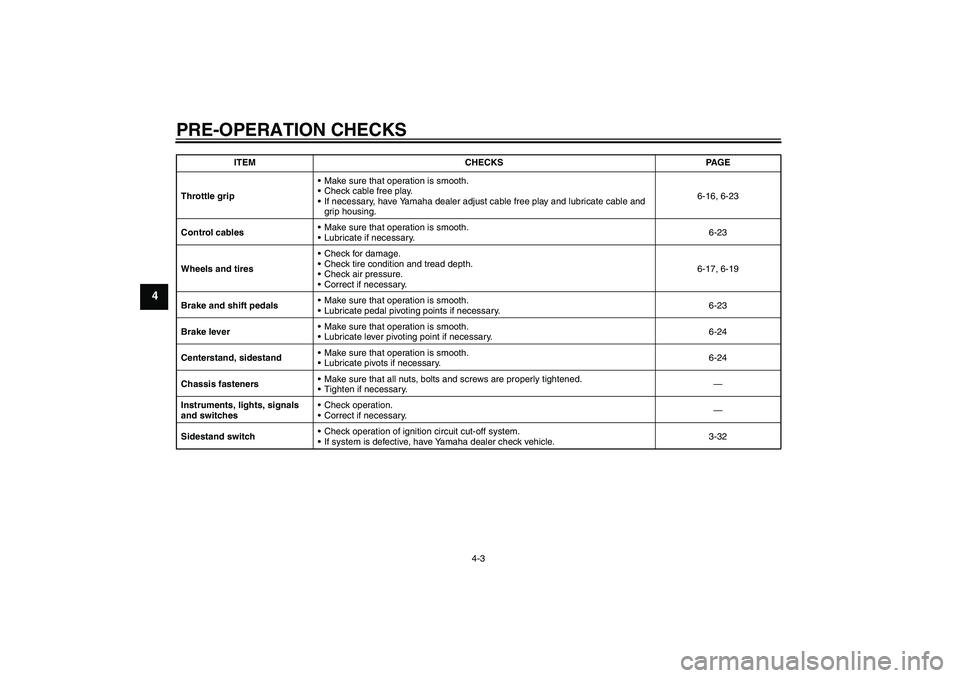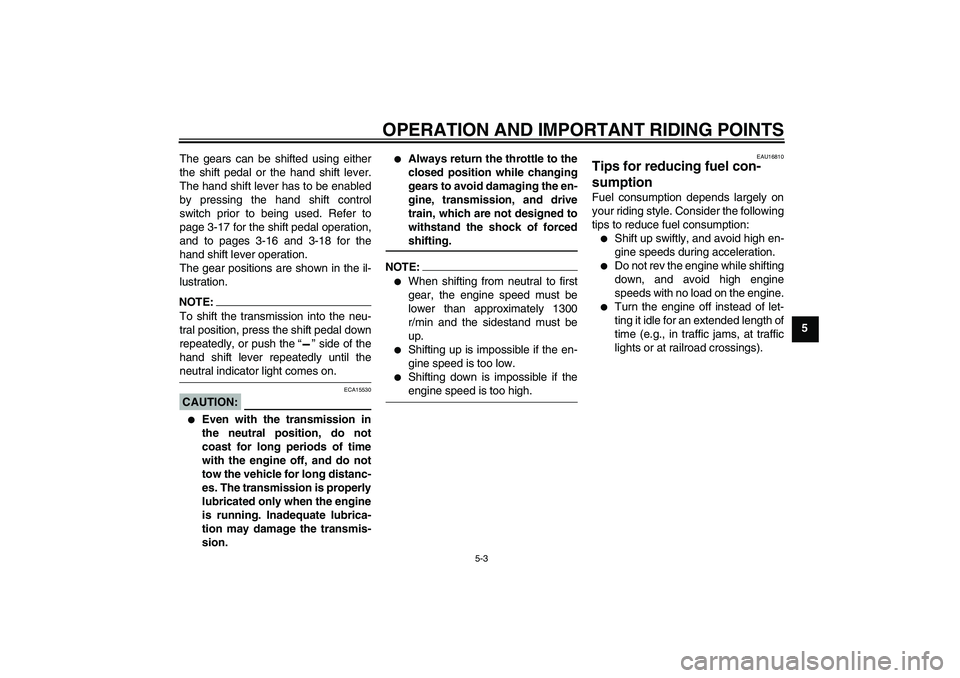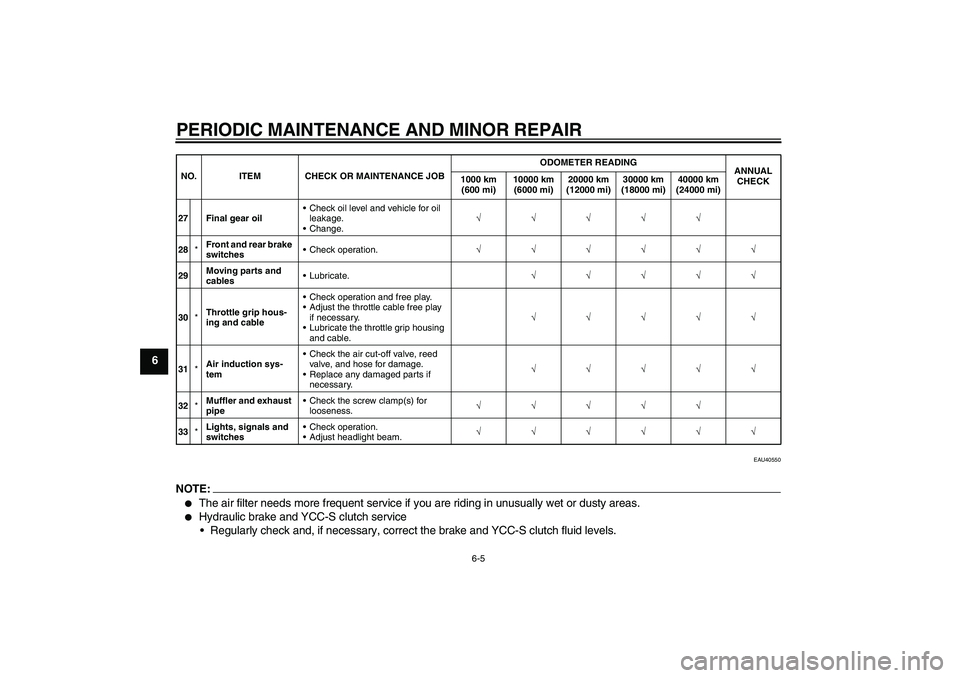Page 41 of 104

INSTRUMENT AND CONTROL FUNCTIONS
3-27
3
EAU39611
Adjusting the headlight
beams The headlight beam adjusting knobs
are used to raise or lower the height of
the headlight beams. It may be neces-
sary to adjust the headlight beams to
increase visibility and help prevent
blinding oncoming drivers when carry-
ing more or less load than usual. Obey
local laws and regulations when adjust-
ing the headlights.
To raise the headlight beams, turn the
knobs in direction (a). To lower the
headlight beams, turn the knobs in di-
rection (b).
EAU39641
Handlebar position The handlebars can be adjusted to one
of three positions to suit the rider’s pref-
erence. Have a Yamaha dealer adjust
the position of the handlebars.
EAU39621
Opening and closing the cowl-
ings The cowlings can be tilted back 30 mm
(1.18 in) for added ventilation to suit the
riding conditions.
To open a cowling
1. Remove the quick fastener
screws.
1. Headlight beam adjusting knob
1. Handlebar
1. Closed position
2. Open position
3. Cowling
U2D2E2E0.book Page 27 Thursday, October 11, 2007 9:15 AM
Page 47 of 104
INSTRUMENT AND CONTROL FUNCTIONS
3-33
3 below and have a Yamaha dealer re-
pair it if it does not function proper-
ly.
EAU40522
Ignition circuit cut-off system The ignition circuit cut-off system (com-
prising the sidestand switch and brake
light switches) has the following func-
tions.�
It prevents starting when the side-
stand is up, but neither brake is ap-
plied.
�
It prevents starting when either
brake is applied, but the sidestand
is still down.
�
It cuts the running engine when the
sidestand is moved down.
Periodically check the operation of the
ignition circuit cut-off system according
to the following procedure.WARNING
EWA10260
�
The vehicle must be placed on
the centerstand during this in-
spection.
�
If a malfunction is noted, have a
Yamaha dealer check the sys-tem before riding.
U2D2E2E0.book Page 33 Thursday, October 11, 2007 9:15 AM
Page 52 of 104

PRE-OPERATION CHECKS
4-3
4
Throttle gripMake sure that operation is smooth.
Check cable free play.
If necessary, have Yamaha dealer adjust cable free play and lubricate cable and
grip housing.6-16, 6-23
Control cablesMake sure that operation is smooth.
Lubricate if necessary.6-23
Wheels and tiresCheck for damage.
Check tire condition and tread depth.
Check air pressure.
Correct if necessary.6-17, 6-19
Brake and shift pedalsMake sure that operation is smooth.
Lubricate pedal pivoting points if necessary.6-23
Brake leverMake sure that operation is smooth.
Lubricate lever pivoting point if necessary.6-24
Centerstand, sidestandMake sure that operation is smooth.
Lubricate pivots if necessary.6-24
Chassis fastenersMake sure that all nuts, bolts and screws are properly tightened.
Tighten if necessary.—
Instruments, lights, signals
and switchesCheck operation.
Correct if necessary.—
Sidestand switchCheck operation of ignition circuit cut-off system.
If system is defective, have Yamaha dealer check vehicle.3-32 ITEM CHECKS PAGE
U2D2E2E0.book Page 3 Thursday, October 11, 2007 9:15 AM
Page 54 of 104

OPERATION AND IMPORTANT RIDING POINTS
5-2
5
CAUTION:
ECA15510
The following warning lights, indica-
tor light and indicators should come
on for a few seconds, then go off.�
Oil level warning light
�
Engine trouble/YCC-S indica-
tors and warning light
�
Immobilizer system indicator
light
�
ABS warning light
If a warning or indicator light, or an
indicator does not go off, see page
3-4 for the corresponding circuit
check.
2. Shift the transmission into the neu-
tral position with the front or rear
brake applied.NOTE:When the transmission is in the neutral
position, the neutral indicator light
should be on, otherwise have a
Yamaha dealer check the electrical cir-cuit.
3. Start the engine by pushing the
start switch.
NOTE:If the engine fails to start, release the
start switch, wait a few seconds, and
then try again. Each starting attempt
should be as short as possible to pre-
serve the battery. Do not crank the en-
gine more than 10 seconds on any oneattempt.CAUTION:
ECA11040
For maximum engine life, never ac-
celerate hard when the engine iscold!
EAU40572
Shifting Shifting gears lets you control the
amount of engine power available for
starting off, accelerating, climbing hills,
etc.1. Shift pedal
2. Neutral position
1. Hand shift lever
2. Neutral position
U2D2E2E0.book Page 2 Thursday, October 11, 2007 9:15 AM
Page 55 of 104

OPERATION AND IMPORTANT RIDING POINTS
5-3
5 The gears can be shifted using either
the shift pedal or the hand shift lever.
The hand shift lever has to be enabled
by pressing the hand shift control
switch prior to being used. Refer to
page 3-17 for the shift pedal operation,
and to pages 3-16 and 3-18 for the
hand shift lever operation.
The gear positions are shown in the il-
lustration.
NOTE:To shift the transmission into the neu-
tral position, press the shift pedal down
repeatedly, or push the“” side of the
hand shift lever repeatedly until theneutral indicator light comes on.CAUTION:
ECA15530
�
Even with the transmission in
the neutral position, do not
coast for long periods of time
with the engine off, and do not
tow the vehicle for long distanc-
es. The transmission is properly
lubricated only when the engine
is running. Inadequate lubrica-
tion may damage the transmis-
sion.
�
Always return the throttle to the
closed position while changing
gears to avoid damaging the en-
gine, transmission, and drive
train, which are not designed to
withstand the shock of forcedshifting.
NOTE:�
When shifting from neutral to first
gear, the engine speed must be
lower than approximately 1300
r/min and the sidestand must be
up.
�
Shifting up is impossible if the en-
gine speed is too low.
�
Shifting down is impossible if theengine speed is too high.
EAU16810
Tips for reducing fuel con-
sumption Fuel consumption depends largely on
your riding style. Consider the following
tips to reduce fuel consumption:�
Shift up swiftly, and avoid high en-
gine speeds during acceleration.
�
Do not rev the engine while shifting
down, and avoid high engine
speeds with no load on the engine.
�
Turn the engine off instead of let-
ting it idle for an extended length of
time (e.g., in traffic jams, at traffic
lights or at railroad crossings).
U2D2E2E0.book Page 3 Thursday, October 11, 2007 9:15 AM
Page 62 of 104

PERIODIC MAINTENANCE AND MINOR REPAIR
6-5
6
EAU40550
NOTE:�
The air filter needs more frequent service if you are riding in unusually wet or dusty areas.
�
Hydraulic brake and YCC-S clutch service
Regularly check and, if necessary, correct the brake and YCC-S clutch fluid levels.
27 Final gear oilCheck oil level and vehicle for oil
leakage.
Change.√√√√√
28*Front and rear brake
switchesCheck operation.√√√√√√
29Moving parts and
cablesLubricate.√√√√√
30*Throttle grip hous-
ing and cableCheck operation and free play.
Adjust the throttle cable free play
if necessary.
Lubricate the throttle grip housing
and cable.√√√√√
31*Air induction sys-
temCheck the air cut-off valve, reed
valve, and hose for damage.
Replace any damaged parts if
necessary.√√√√√
32*Muffler and exhaust
pipeCheck the screw clamp(s) for
looseness.√√√√√
33*Lights, signals and
switchesCheck operation.
Adjust headlight beam.√√√√√√ NO. ITEM CHECK OR MAINTENANCE JOBODOMETER READING
ANNUAL
CHECK 1000 km
(600 mi)10000 km
(6000 mi)20000 km
(12000 mi)30000 km
(18000 mi)40000 km
(24000 mi)U2D2E2E0.book Page 5 Thursday, October 11, 2007 9:15 AM
Page 65 of 104

PERIODIC MAINTENANCE AND MINOR REPAIR
6-8
6 To install the panel
1. Place the panel in the original posi-
tion, and then install the bolts and
the quick fastener screws.
2. Install the seats.
EAU19642
Checking the spark plugs The spark plugs are important engine
components, which should be checked
periodically, preferably by a Yamaha
dealer. Since heat and deposits will
cause any spark plug to slowly erode,
they should be removed and checked
in accordance with the periodic mainte-
nance and lubrication chart. In addition,
the condition of the spark plugs can re-
veal the condition of the engine.
The porcelain insulator around the cen-
ter electrode of each spark plug should
be a medium-to-light tan (the ideal color
when the vehicle is ridden normally),
and all spark plugs installed in the en-
gine should have the same color. If any
spark plug shows a distinctly different
color, the engine could be operating im-
properly. Do not attempt to diagnose
such problems yourself. Instead, have
a Yamaha dealer check the vehicle.
If a spark plug shows signs of electrode
erosion and excessive carbon or other
deposits, it should be replaced.
1. Panel B
2. Bolt
3. Quick fastener screw
1. Panel C
2. Bolt
3. Quick fastener screw
1. Panel B
1. Panel C
U2D2E2E0.book Page 8 Thursday, October 11, 2007 9:15 AM
Page 66 of 104

PERIODIC MAINTENANCE AND MINOR REPAIR
6-9
6Before installing a spark plug, the spark
plug gap should be measured with a
wire thickness gauge and, if necessary,
adjusted to specification.
Clean the surface of the spark plug
gasket and its mating surface, and then
wipe off any grime from the spark plug
threads.
NOTE:
If a torque wrench is not available when
installing a spark plug, a good estimate
of the correct torque is 1/4–1/2 turn
past finger tight. However, the spark
plug should be tightened to the speci-fied torque as soon as possible.
EAU19883
Engine oil and oil filter car-
tridge The engine oil level should be checked
before each ride. In addition, the oil
must be changed and the oil filter car-
tridge replaced at the intervals speci-
fied in the periodic maintenance and
lubrication chart.
To check the engine oil level
1. Place the vehicle on the center-
stand.NOTE:
Make sure that the vehicle is positioned
straight up when checking the oil level.
A slight tilt to the side can result in afalse reading.
2. Start the engine, warm it up for
several minutes, and then turn it
off.
3. Wait a few minutes until the oil set-
tles, and then check the oil level
through the check window located
at the bottom-left side of the crank-
case.
Specified spark plug:
NGK/CR8E
DENSO/U24ESR-N1. Spark plug gapSpark plug gap:
0.7–0.8 mm (0.028–0.031 in)
Tightening torque:
Spark plug:
12.5 Nm (1.25 m·kgf, 9.0 ft·lbf)
U2D2E2E0.book Page 9 Thursday, October 11, 2007 9:15 AM